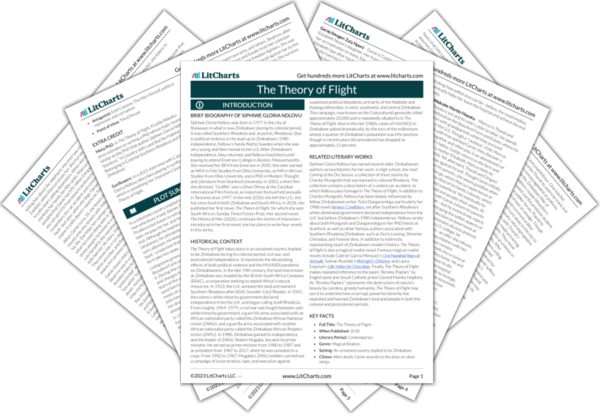In The Theory of Flight, sunflowers symbolize the history that its characters share despite their disparate individual personalities, demographics, and commitments. The colonizer father of white heiress Beatrice Beit-Beauford plants sunflowers on the estate he has bought in an unnamed African country implied to be Zimbabwe because he has noticed that his daughter loves them. Sunflowers originated in the Americas; European colonizers of the Americas brought them back to Europe and spread them elsewhere. Thus, the planting of sunflowers on a colonial farm in Zimbabwe represents, in the first instance, the impact of global colonialism on Zimbabwe’s land and local culture.
After Zimbabwe’s independence, young children Genie and Marcus discover the sunflower fields first planted for Beatrice. They (particularly Genie) love the sunflowers for their beauty and begin playing regularly in the field, which represents how people in countries that have been colonized both inherit the colonial past and can repurpose it for their own ends. Moreover, the sunflowers’ death and rebirth with the seasons teach Genie and Marcus about life cycles, which symbolize history’s continuity: individuals may live and die, and a country may be named and renamed, but a land’s history continues across those changes. When Genie is beginning the process of dying after decades of carefully managing her HIV, she compares herself to a sunflower, considering herself simultaneously “rooted” and capable of flight. This incongruous juxtaposition of images—rooted things and flying things—indicates that each person is made up both of their individual aspirations and of their group history, the context in which they are “rooted.” Genie ultimately chooses to return to the sunflower field to die—and her loved ones follow her there, so that her death among the sunflowers reunites disparate and scattered individuals into a group made up of shared loves and histories. Thus, the novel uses the sunflowers to celebrate the power of group history—both negative and positive—without suggesting that individuals like Genie can be reduced purely to their historical context.
Sunflowers Quotes in The Theory of Flight
So engrossed were they in their travels that it took them a while to notice that shoots were beginning to rise out of the reddish-brown earth. The sunflowers were being reborn. This was how they learned their most valuable lesson about death—that after it there is life again, that things that perish will rise again, that after every ending there is another beginning.
Funny that during her final moments her thoughts and concerns should be so domestic.
After a lifetime of believing she was in flight, of believing that she was something spectacular in the sky, had she rather been a hybrid thing—something rooted but free to fly? Could such a hybrid thing even exist?












